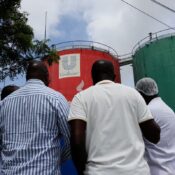
Tshisekedi’s massive arsenal in Goma and his invasion strategy for Rwanda
The New Times delves deeper into what some have called glaring evidence of DR Congo’s mind-blowing invasion plot of Rwanda in the final installment of our five-part “Stories from Goma” series.
Goma was the focal point of President Félix Antoine Tshisekedi’s response to the M23 rebellion’s resurgence in 2021. The city fell to M23 rebels after the airport was taken on January 28.
Consequently, the city, which has a population of about 2 million, became the center of military operations against the rebels who had returned from Uganda undetected and rearmed.
They held Kinshasa accountable for its own failure to fulfill promises that had contributed to the resolution of a previous M23 conflict in 2013, which was the consequence of unmet promises from a March 2009 agreement that gave rise to the organization’s name, the March 23 Movement, or M23.
Before M23’s march on Goma, there had been rumors that Tshisekedi and his supporters had transformed the lakeside city into a heavily fortified area. According to some, the government coalition had gathered about 60,000 fighters in and around Goma alone, and they had poured a lot of heavy weapons into the area.
The pro-Tshisekedi forces essentially gathered in Goma, a twin metropolis of Rwanda’s border city of Rubavu, where they were able to coordinate their combat activities, share intelligence, and operate the main joint command center.
The infamous Wazalendo militias, the Congolese army (FARDC), Burundian government forces, SADC troops, European mercenary fighters, UN peacekeepers under MONUSCO, Force Intervention Brigade (FIB, a MONUSCO wing with an offensive mandate), and the genocidal FDLR, a UN-sanctioned terrorist organization with roots in the 1994 Rwandan Genocide against the Tutsi, were all part of the alliance.
Kigali, which denied that it was responsible for M23, expressed concern over the DR Congo’s concentration of heavy military equipment and tens of thousands of combat-ready troops and militias close to the Rwandan border.
Kinshasa was accused by President Paul Kagame’s administration of raising tensions by using defamatory language, shelling over the border, and allowing DR Congo’s jets to violate Rwandan airspace.
The situation was made worse by Tshisekedi’s frequent public statements that he was prepared to implement “regime change” in Rwanda, even going so far as to claim he would accomplish this goal without even entering the country.
Rwanda responded by saying it had implemented defenses to fend off any potential assault.
Later, after M23 reached the city, Rwanda would use its defensive technology to stop a flurry of shells thrown from the FARDC coalition camp across the border in Goma. After almost two days of fierce combat near the airport, it finally captured the city late last month.
Untended arsenals of weapons
They left behind caches of contemporary weapons, ammunition, and other military hardware as FARDC, Burundian forces, and genocidal FDLR and Wazalendo militias fled in chaos and the other coalition partners withdrew to their bases.
To the gratification of M23, this situation has recurred numerous times during the fight.
The type of weapons that Tshisekedi had gathered in Goma, however, would have surprised few.
Of weapons and armories left in ruins on battlefields…
We observed a lot of weaponry for hours when The New Times went to a large lakeside arsenal and several of the battlegrounds where there was intense combat, such as Goma airport and Mubambiro barracks.
The majority of them, with their labels and volume numbers still attached, were securely stored in their shipment containers.
Most of the captured fighter planes, armored personnel vehicles, battle tanks, and artillery guns were in a state of disorder and mostly undamaged at both Goma and Mubambiro airports.
The majority of the weapons were kept at the main armory near Lake Kivu, but there were a few smaller armories around Goma airport, the most of which were still in good condition.
Although they had left many others intact, we noticed one mobile armory at the airport that had been set on fire by escaping Burundian forces. This shows that time was not on their favor as M23 rushed into the city.
Large wooden or metallic ammo boxes or corrugated cardboard boxes, mostly meticulously organized in columns taller than my head, held the majority of the ammunition.
Unexploded grenades (unexploded ordnance), brand-new fatigues, flak jackets, military water bottles, and helmets were among the many types and calibers of ammunition that were left on these war-torn battlefields.
Since we visited over two weeks after the rebels captured Goma, we were informed that many of the guns and other equipment that had been seized had been carried out and sent to the battlegrounds.
Still, there was a lot to see.
Grad multiple missile launchers for the BM-21
A 40-barreled BM-21 Grad multiple rocket launcher vehicle was spotted at Goma airport. We found out that four of them were taken into custody at the airport. With its 20–40 kilometer firing range, the Grad can be utilized to hit a target region in Nyabihu District from this position.
Because Grads are not precision weapons, each rocket can generate several explosions and fragmentation effects, destroying a huge area in a single burst without allowing victims to react. The Soviet-made weapon has a 20-second launch time for 40 missiles.
A retired field artillery officer told The New Times this week that the Grad is a particularly hazardous weapon that can launch a salvo of artillery weaponry.
Before accounting for transportation expenses, our analysis revealed that the cost of an M-21 Grad multiple rocket launcher system is $2.3 million per unit.
RM-70 21 BM 122mm launchers
At the airport, 122mm RM-70 21 BM weapons that can shoot more than 20 kilometers afar were also confiscated. The RM-70, like the Glad, can use almost 250 kg of explosives to fire 40 rockets in a salvo. With 40 barrels, the Czechoslovakian-made RM-70 can fire a range of warheads. More than 2200 of these missiles were captured by M23 in Goma alone. According to our online research, the price of a rocket can reach $2,000, not including transportation and other related expenses.
D-30 howitzers, 122mm
With its 360-degree traversal capability, the 122-meter D-30 howitzer is a wheeled, towed piece of artillery. The airport saw the seizure of at least two howitzers. Last week, when we went there, they were still there. A howitzer can fire up to 21.9 km using rocket-assisted projectile ammunition, however it can only fire 15.4 km with normal HE-Frag shells.
107 missile launchers from Katyusha
“Approximately four 107mm Katyusha multiple rocket launchers” were also confiscated at the airport, according to a high-ranking source in the M23 forces that took control of the airport.
A multiple rocket launcher with a high explosive warhead that delivers explosives to a target area, the Katyusha (Russian for “little katy”) was first deployed by the Soviet Union during World War II. It is compatible with practically any chassis and has an effective shooting range of 11 km. Its precision falls inside an area that would cover multiple football fields combined.
Nonetheless, a few contemporary Katyusha rocket variations may shoot between 40 and 80 kilometers. The Goma lakeside armory grabbed around a thousand Katyusha rockets. When Israel first introduced its protective Iron Dome system in 2011, it had difficulty stopping Hezbollah’s Katyusha rockets.
A single 107mm Katyusha rocket still costs over $300 each round, according to internet sources, despite the fact that Katyusha rockets are renowned for being reasonably priced when compared to more sophisticated missile systems.
Three thousand shells, 37mm anti-aircraft guns…
A number of 37mm anti-aircraft guns and at least 3,000 ammunition were also taken by the rebels in Goma alone. Trailers, stationary installations, and self-propelled vehicles are just a few of the ways in which this cannon might be employed. It can shoot between 150 and 180 rounds per minute, and its effective slant range is 2,499 meters. 7 kilometers away, it can hit targets.
At first, the cost of this anti-aircraft weapon remained unclear.
Three hundred shells, 20mm anti-aircraft…
atop the airport runway, two 20mm self-propelled anti-aircraft cannons mounted atop Anti-Personnel Carriers, or APCs, were lying among the wreckage of battle. This piece of artillery can move across the battlefield on its own and fire quickly in various locations without assistance from other sources.
At the airport, over 300 of their shells and at least two of these were taken. The 20mm self-propelled anti-aircraft cannon, which is mostly useful against low-flying aircraft at short to medium range up to 7km, costs several million dollars per unit, depending on the system, according to information we discovered online.
Two thousand mortar rounds and guided 120mm mortar weapons…
For infantry operations, the guided 120mm mortar is a high-precision weapon with a shooting range of up to 8 kilometers (but some versions can exceed 13 km). Using a system with pyrotechnic control and high-explosive capabilities, it provides friendly troops with precision-strike capabilities that may be used to target hostile assets and forces. Because of built-in extra guidance systems like GPS, this kind of mortar is essentially a guided projectile that can attack numerous targets with a single placement.
The lakeside weapon arsenal seized almost two thousand mortar rounds (shells).
Tanks together with 20mm and 30mm anti-aircraft weaponry…
Numerous more artillery support weapons were also taken by the rebels, such as 20mm anti-aircraft (with around 2000 shells) and 30mm anti-aircraft systems (with at least 2000 rockets), both of which could reach a target seven kilometers away.
Additionally, the M23 took at least four tanks with at least 300 shells and 100m anti-tank and field guns at the airfield. Regular artillery shells cost about $2,000 each, according to online information, while tanks can fetch several hundred thousand dollars each, depending on their condition.
Containers filled with weapons, millions of cartridges, thousands of shells…
Large amounts of integral weaponry were also taken by M23, including 60mm mortar launchers, 73mm SPG-9 recoilless anti-tank rifles, and 82mm mortars, together with almost 400 shells from the latter.
More than a million ammunition and 12.7mm anti-aircraft machine guns are among the others. A machine gun was listed over a decade ago for about $2,250 per unit. Tens of thousands of cartridges were available, as well as different kinds of machine guns.
We also saw rocket-propelled grenades (RPGs) at the armory. These shoulder-fired weapons shoot rockets with explosive warheads. You can use an RPG to destroy helicopters, cars, and tanks.
An M23 officer gave us a tour of the armory, which had about 40 containers of seized weapons, and told us that they also had long range sniper guns for targeted killings and over 300,000 cartridges taken from FARDC and their friends. Additionally, boxes carrying almost 300 million cartridges of SMGs—lightweight, automatic weapons with short barrels intended for close-quarters combat—were taken by them.
Fighter jets, weapons labeled Burundi…
We moved between weapon-loaded containers at the lakeside weaponry stockpile for over an hour. Each container was filled with stacks of unsealed ammunition boxes, including RPG rockets. A few RPG rocket cases had labels from Burundi.
The FARDC-led alliance also left a number of fighter planes at the airport, including a Russian-built Suhkoi-25, a key weapon in President Tshisekedi’s inventory in his struggle against M23, together with all of its parts, including pods, 20,000 C-8 rockets, and Ofab bombs.
At the airfield, the rebels also discovered three military helicopters.
Reconnaissance aircraft, suicide drones, etc.
A number of drones, including Kamikaze drones—also known as suicide drones—were caught in Mubambiro, according to The New Times. They are also referred to as loitering drones and are capable of carrying a range of explosive payloads. They can linger over a target until they receive an order to strike.
Kamikaze drones, in contrast to conventional drones, are only employed once because they kill themselves while hitting their target. The price of an aerial weapon with an integrated warhead ranges from $1000 to $35,000, depending on the model. Many of these lethal weapons, as well as their accessories, such as batteries, were visible to our reporter at Mubambiro.
Additionally, we observed military trucks, Cobra II APCs, damaged artillery and light weaponry, and a number of unmanned aerial aircraft outfitted with cameras and sensors for reconnaissance.
Although some can cost as much as $180,000, a single Cobra II unit may cost as much as $880,000.
Tanks, ammo, and other SADC contingent equipment were also burned out here. On the day that the rebels took control of this crucial installation close to Sake, an M23 Major who oversaw the attack on Mubambiro brought us to a location where South African SADC forces left a variety of weapons.
Weapons that South African troops left behind
Among the weaponry that the South Africans left behind are filled magazines, MG chains, anti-tank grenades, LG5 grenades, RPGs, and SPG 9s.
According to the commander, the South African FIB/MONUSCO unit battled with the SADC forces and FARDC special forces (Hiboux or Owls) here. The former had previously relocated from Beni to this camp after the South African SADC troops reached Mubambiro.
The M23 officer informed us that they had asked to be moved to Mubambiro in order to be in a position to provide logistical support to fellow members of the South African National Defence Forces (SANDF) who were arriving here as part of the combat SADC Mission. They were successful in doing so.
South African officials acknowledged that their SADC combat operation was supported by the FIB/MONUSCO contingent in their nation.
We discovered at Mubambiro that, following the withdrawal of European mercenaries and DR Congo’s Hiboux special forces from the conflict on January 24, South African troops were the last line of defense against the M23 attack. The leader of the South African SADC contingent at the base wrote a letter to the M23 commander here asking for permission to retrieve the bodies of their dead countrymen. The New Times reported that more a dozen South African soldiers lost their lives here on that day.
Getting past the enemy’s defenses
The struggle for Mubambiro lasted a day and a half, same like at Goma airport. M23 used their strategic positions at neighboring hills, such as Ngingwe, Rukara, Muremire, Kiluku, and Kwa-Madimba, to keep Goma reinforcements at bay and overrun the base.
One of the most important elements in this battle would be an M23 unit that broke through the German defenses to capture the Bulengo peninsula before behind-the-barracks attacking.
The buildings at this military compound are still scarred from the war, and several of them have been severely damaged by shelling that appears to have come from many directions.
The day M23 took control of the site, at least five tanks were destroyed, including one that belonged to South Africa’s offensive FIB/MONUSCO contingent.
The SADC troops were limited to their own encampments at the base when we visited Mubambiro on February 11; white flags, which signify surrender or a truce, were flying above their bases.
“No possibility.”
The SADC soldiers here still had firearms in their camps, just like at Goma airport, but an M23 source we spoke to denied that they would be permitted to take their guns when their nations finally agreed to remove them.
The battle-hardened leader, whose men successfully defended their positions in a vital range of highlands northwest of low-lying Sake and Mubambiro for over a year prior to their overwhelming offensive last month, declared, “No chance.”
In other places, such as at a former mercenary base at Trois Antennes in Kibati and Kirimanyoka, both in Nyiragongo area, The New Times also discovered artillery guns that were taken by M23. Some of the weapons were burned out, while others appeared to be in fair condition. Additionally, we found out that the rebels took several other weapons from at least three hotels in Goma where European mercenaries had set up camp.
“Those weapons weren’t meant to be used against a small rebel group.”
The amount of weapons that have been gathered in and around Goma has left observers perplexed, and many have pointed to this as unquestionable proof that Tshisekedi intends to carry out his blatant threats against Rwanda.
In its fight against M23, Tshisekedi’s administration is thought to have spent billions of US dollars on military equipment and technology; some estimates place this figure at $4 billion.
A retired Colonel was asked what he thought of the Congolese government’s contiguous deployment of its coalition forces, including the genocidal FDLR, near the Rwandan border and the military arsenal it had gathered in Goma. He responded, “Those weapons were not for attacking a small rebel group like M23, they had been assembled to invade Rwanda.”
“What was happening right on our border over there is mind-boggling,” he remarked. “M23 might as well have prevented a significant attack on Rwanda; it was only a matter of time.”
All Categories
Recent Posts
Tags
+13162306000
zoneyetu@yahoo.com


